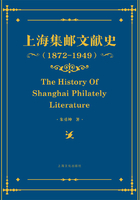
Abstract
Shanghai is one of the birthplaces of China's philately. In the early 20th century, stamp collecting had an inkling in Shanghai. In China, the earliest philatelic organization should be the Shanghai Philatelic Society founded by Westerners in 1912 in Shanghai. Ten years later, the China Stamp Research Society, the first influential philatelic organization established by Chinese stamp-collectors, came into being here. Later, the budding China Philatelic Society, New Light Philatelic Society and Chia Hsu Philatelic Society became China's most influential philatelic societies in succession. Zhangbao Zijun's comment on these three societies is:“in terms of China's three philatelic societies, most articles on academic research came from the China Philatelic Society, the New Light Philatelic Society won at its number of domestic and foreign members, while the advantage of the Chia Hsu Philatelic Society is its large domestic promotion”. Just as a stamp-collector said, speaking of China's history of philately, the history of these three societies cannot be ignored; if a discussion on the history of China's philatelic research publication neglects journals of the three societies, there will leave a large gap.
However, during the Republic of China, both the earliest and the most important philatelic publications appeared in Shanghai, a metropolis infested with foreign adventurers, the largest city in the Far East and the third-largest city in the world. A stamp collecting advertisement, Purchase ‘Old Man's Heads' on Envelopes, issued on Shanghai's Shun Pao on May 2, 1872 is the earliest philatelic literature in China. In 1880,“Stamps of Post Offices from Various Countries” published on Shanghai's“Huatu New Paper” is the earliest philatelic article in China. In 1918, the“Philately World” published in Shanghai is the earliest philatelic publication in China. In this period in Shanghai, the China Philatelic Society, the New Light Philatelic Society and stamp merchants such as Chen Zhichuan, Zhong Xiaolu and Chen Fuxiang created stamp journals and papers and famous philatelists including Zhang Gengbo, Shao Xunmei, Ma Renquan and Yuan Hanyun wrote philatelic works. The literature value of these journals, papers and works carrys a big weight in China's history of philately, stamps and postal service. Therefore, China's history of stamps cannot be discussed without mentioning Shanghai's history of philatelic literature.
The good news is that in recent years, some philatelic societies and journals as well as stamp collectors have devoted themselves to collecting historical materials of philatelic literature during the Republic of China. In the course of research on philatelists such as Zhou Jinjue, Zhang Gengbo, Shao Xunmei, Chen Fuxiang, Zhong Xiaolu, Ma Renquan, Yuan Hanyun, Villard R.A and Juan Mancarini and their works, facts and truth were discovered and explored and old local records were rectified, enhancing depth and breadth of philatelic literature research.However, there are only a few people who have carried out deep research on philatelic literature, especially the philatelic literature during the Republic of China. As early as five years ago, ZHU Yongkun told me that he wanted to write historical annals about Shanghai philatelic literature. I think highly of his courage and insight to write this book all by himself, but sigh that he chose a tough challenge.
This is a book about special philatelic history. However, as it is a large special subject involving most contents in the history of modern China's stamp collection as well as some contents of philately, he needs to make great efforts to finish this book. Before, there was no specialized systemic work for the history of philatelic literature until this book came out. Thus, it deserves lots of attention.
In order to create a good book, ZHU Yongkun put in great time and energy on material collection. Since the 1990s, he has searched bookstores on the street stalls. Early posts and stamp journals in the period of the Republic of China, including“Post School”,“The New Light”,“China Quintessence Stamp Journal” And“Modern Stamp Journal” are rare and expensive, but he still tries to buy some selectively. In order to occupy rich materials, he also bought four hundred volumes of photocopies of“Shun Pao” and nearly ten thousand kinds of domestic and foreign philately books and periodicals. He rented a farmhouse in Mount Tianmu, Zhejiang with a picturesque scenery. Thus, these books and periodicals could be put in the farmhouse and he could focus on writing with the company of mountains.